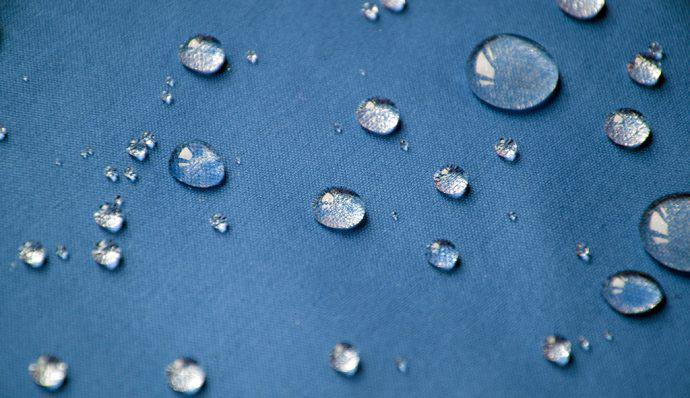What is DWR?
DWR stands for “durable water repellent,” a thin layer of liquid applied to the outside of technical garments to repel oil, grease, dirt, and water. Garments treated with a DWR treatment will not get saturated with water as easily as garments without, and will be less prone to “wet out,” (when saturated outer fabrics get heavy and cling to your skin making you feel clammy and damp). Naturally, rainwear with a DWR treatment will keep you comfortable and dry more effectively than rainwear without.
Rainwear with highly effective DWR is highly desirable in the outdoor world. Instead of soaking to the core, hikers, backpackers, and campers who wear rainwear with DWR can roll or shake off water and remain dry inside and out. Unfortunately, a DWR treatment is not a permanent property of most outerwear and periodic care is necessary to maintain peak performance.
How does DWR work?
DWR is science at work.
Have you ever seen how many drops of water you can put on a penny in a science class? (Try it if you haven’t, it’s really surprising.) The water stacks up and forms a tall bubble. The tall water droplet has a high contact angle with the penny. When the droplet finally bursts and the water spreads out, the contact angle is very low.

Similarly, an effective DWR treatment keeps water droplets at a high contact angle with the fabric of the rainwear. This minimizes the surface area of the wetted fabric and better allows water droplets to roll off. Less water on the outer fabrics allows the technical waterproof fabric to breathe its best which helps keep you more comfortable. More importantly, keeping dry is a vital component to staying safe on any adventure.
How Long Does DWR Last and How Can I Test My Jacket?
How long a DWR treatment lasts depends mainly on garment use. If you use your garment several times each week for intense periods of activity, the DWR will not last as long as a jacket that is used, say, only a few times per month. And DWR applied at the factory to a new garment typically lasts longer than reapplications.
To test your jacket’s DWR, sprinkle on some water. If the water beads up, your DWR is in good shape. If the water soaks in and obvious darker areas appear, it is time to restore your DWR. Be sure to test your jacket all over, as soaking can occur from any breach.
How Do I Restore Existing DWR?
Restoring your factory applied DWR is easy, simply wash and apply heat. To restore the water repellency of GORE-TEX outerwear, GORE-TEX brand recommends the following steps:
- Machine wash your garment as described in the wash instructions. Line dry your garment or tumble dry it on a warm, gentle cycle.
- Once it is dry, tumble dry your garment for 20 minutes to reactivate the durable water-repellent (DWR) treatment on the outer fabric.
- If unable to tumble dry, iron the dry garment on the gentle setting (warm, no steam) by placing a towel or cloth between the garment and the iron. This will help reactivate the DWR treatment on your garment’s outer fabric.
These steps will restore the factory durable water repellent treatment and water may bead up on your outerwear. If it does not, it’s probably time to apply new DWR to your jacket.
How do I apply a new DWR treatment?
Sometimes, the factory applied treatment can no longer be reactivated. In that case, apply a new water-repellent treatment available as a pump-spray or wash-in product to the garment's outer fabric.
Check the label on your jacket to verify the appropriate option. Spray-on products are easy to apply using the built-in pump.
Should I Use a Spray-On or a Wash-In Product to Restore My DWR?
Both products will work to restore the DWR to the exterior of the garment. The main concern with wash-in products is that the DWR is also applied to the inside of the clothing. This may compromise the ability of the interior fabric to wick perspiration away from your skin, and may adversely impact garment breathability.
A wide variety of DWR products are available and, as of 2016, new DWR formulas are entering the market. The three main groups are fluorocarbon-based, silicone-based, and hydrocarbon-based polymers. It’s worth noting that each type has its strengths and weaknesses, such as repelling oils and dirt very well, but water not as well or vice versa. Something else to keep in mind is that the product you used previously may have had a change in the formula as a result of improved performance or environmental impact.
Will Restoring the DWR Make My Jacket More Waterproof?
The simple answer is no. DWR is a surface treatment and does not impact the performance of the waterproof membrane.
Both properties are separate, meaning when the DWR wears off, a waterproof jacket is still waterproof. Waterproof ratings are determined without considering DWR. A well-maintained DWR treatment will, however, help your jacket breathe very efficiently by minimizing saturated outer fabric and maximize your comfort.
No matter your product, the story is relatively the same. It’s important to monitor and maintain your jacket for optimal performance.





